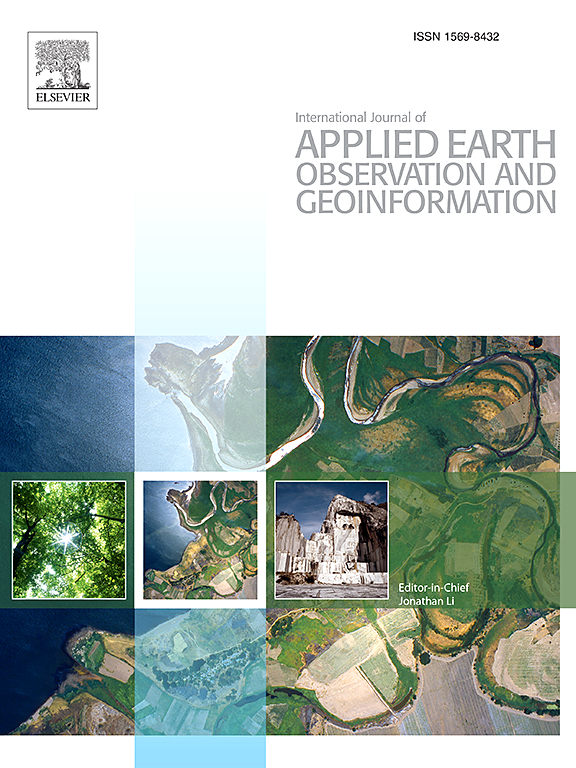Integrating geostatistical methods and deep learning for enhanced 87Sr/86Sr isoscape Estimation: A case study in South Korea
IF 8.6
Q1 REMOTE SENSING
International journal of applied earth observation and geoinformation : ITC journal
Pub Date : 2025-06-28
DOI:10.1016/j.jag.2025.104697
引用次数: 0
Abstract
The 87Sr/86Sr isotopic ratio has emerged as a valuable geochemical tracer in fields such as environmental forensics, archaeology, and provenance research. However, generating accurate and spatially continuous isoscape maps from sparse isotopic measurements remains a major challenge due to limited data availability and spatial heterogeneity. To address this, we propose a hybrid framework for 87Sr/86Sr isoscape mapping that integrates a kriging-based data augmentation method with a deep learning (DL) classifier. The kriging component generates synthetic training samples by interpolating sparse isotopic data while preserving underlying spatial correlations and geological anisotropy. These augmented data, along with spatial geological features (e.g., lithology, tectonic settings) and geochemical compositions, are used as input variables for training a feedforward deep neural network. The approach was applied to 409 soil samples collected across South Korea, and its performance was benchmarked against conventional kriging and convolutional neural networks (CNN). The proposed model achieved significantly higher classification accuracy (91.67%) compared to kriging-based and CNN-based models (76.7% and 86.7%, respectively). Furthermore, the isoscape outputs revealed meaningful isotopic patterns linked to geological and geomorphological controls, such as metamorphic rock distributions, fault density, and surface slope. This framework demonstrates the effectiveness of combining geostatistics with DL to improve predictive accuracy and interpretability in isotopic provenance research and environmental monitoring.
整合地质统计学方法和深度学习增强87Sr/86Sr等值面估算:以韩国为例
87Sr/86Sr同位素比值已成为一种有价值的地球化学示踪剂,在环境法医、考古学和物源研究等领域得到广泛应用。然而,由于有限的数据可用性和空间异质性,从稀疏的同位素测量中生成精确和空间连续的等高线图仍然是一个主要挑战。为了解决这个问题,我们提出了一个用于87Sr/86Sr等高景观映射的混合框架,该框架集成了基于克里格的数据增强方法和深度学习(DL)分类器。克里格分量通过插值稀疏同位素数据生成合成训练样本,同时保留潜在的空间相关性和地质各向异性。这些增强的数据,连同空间地质特征(例如,岩性、构造环境)和地球化学成分,被用作训练前馈深度神经网络的输入变量。该方法应用于韩国各地收集的409个土壤样本,并将其性能与传统的克里格和卷积神经网络(CNN)进行了基准测试。与基于kriging和cnn的模型(分别为76.7%和86.7%)相比,该模型的分类准确率(91.67%)显著提高。此外,等值线图的输出还揭示了与地质和地貌控制有关的有意义的同位素模式,如变质岩分布、断层密度和地表坡度。该框架证明了地质统计学与深度学习相结合在同位素物源研究和环境监测中提高预测精度和可解释性的有效性。
本文章由计算机程序翻译,如有差异,请以英文原文为准。
求助全文
约1分钟内获得全文
求助全文
来源期刊

International journal of applied earth observation and geoinformation : ITC journal
Global and Planetary Change, Management, Monitoring, Policy and Law, Earth-Surface Processes, Computers in Earth Sciences
CiteScore
12.00
自引率
0.00%
发文量
0
审稿时长
77 days
期刊介绍:
The International Journal of Applied Earth Observation and Geoinformation publishes original papers that utilize earth observation data for natural resource and environmental inventory and management. These data primarily originate from remote sensing platforms, including satellites and aircraft, supplemented by surface and subsurface measurements. Addressing natural resources such as forests, agricultural land, soils, and water, as well as environmental concerns like biodiversity, land degradation, and hazards, the journal explores conceptual and data-driven approaches. It covers geoinformation themes like capturing, databasing, visualization, interpretation, data quality, and spatial uncertainty.
 求助内容:
求助内容: 应助结果提醒方式:
应助结果提醒方式:


